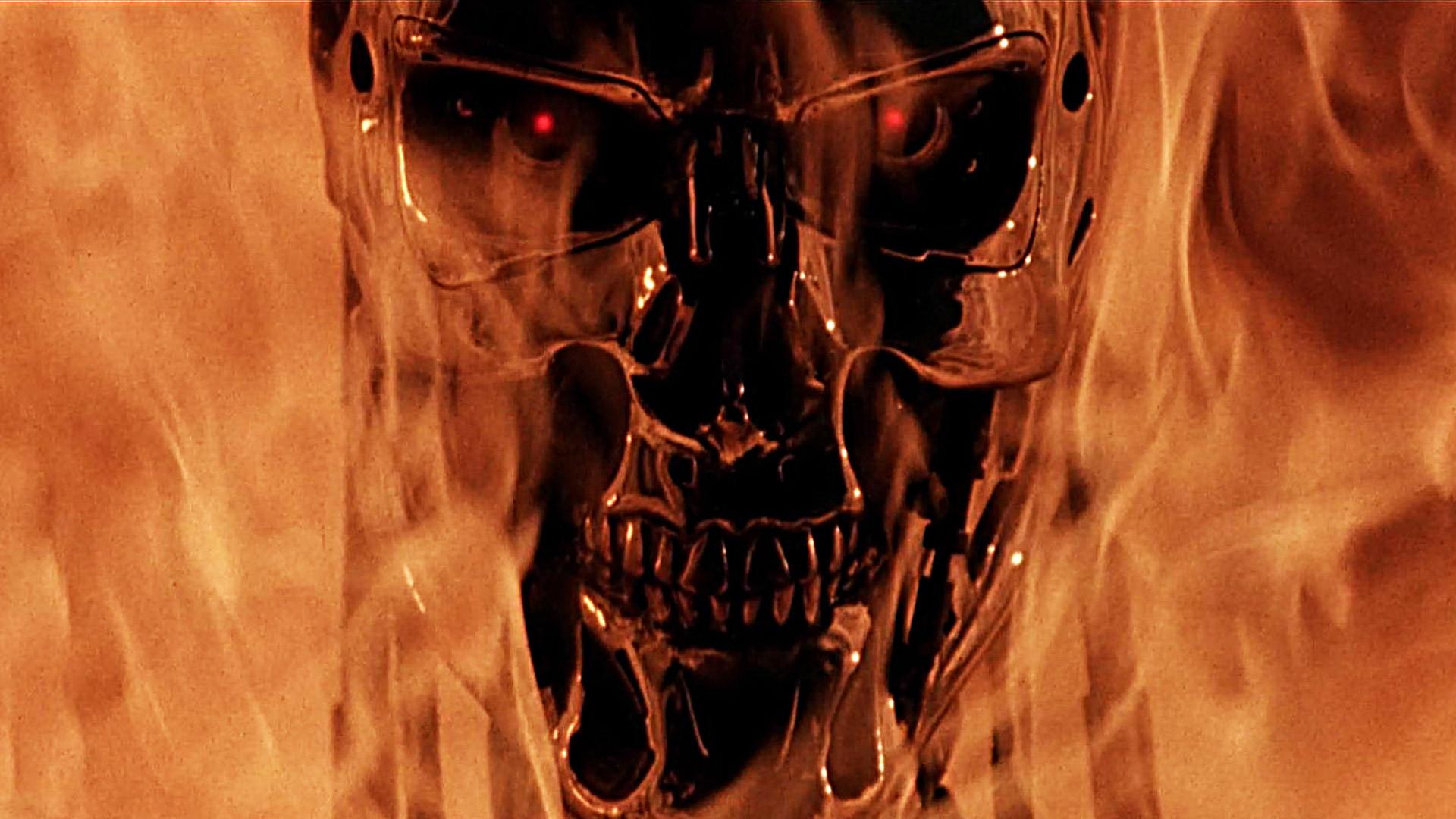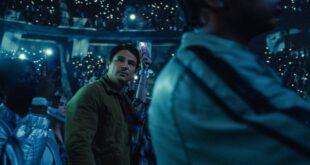This article is in depth look at Terminator 2 and the action genre. Here are my 5 Reasons Why Terminator 2 is the Best Summer Blockbuster of All Time.
NOTE: This article concerns the THEATRICAL version of the film, not the Special Edition.
1. It improves on the original in almost every way.
From inception to completion, Terminator 2 is all about the subversion of expectation. One thing that never fails to amaze me about T2 is the simple fact that it manages to keep the exact same story skeleton of the original (almost beat for beat), while at the same time changing everything we know about that story to make something that we have never seen before. T2 is also rare in the sense that it wholly fits the mold of the summer blockbuster, while at the same time breaking that same mold to provide a follow-up that truly surpasses the original in almost every way. It not only takes the franchise to its next logical conclusion (the direction of the story that the film takes), but it also manages to provide meaningful character work, philosophical debate, and action set pieces that defy what your typical summer blockbusters provide.
It also proves to true to the mythology of the first film, while expanding and building on that mythology in a meaningful way. Perhaps the biggest and most notable instance of this subversion has to be the introductions of our three main characters: John, the T-800, and the T-1000. The screenplay, which was written by director James Cameron and writer William Wisher, has a very tight structure to it, and the subversion of expectation stems from the way that our characters are introduced through their ingenious scripting in the first act. John, who is introduced in the opening sequence as the man we have all been told he would become, is in later scenes revealed to be the exact opposite of that. When the T-800 is introduced after the opening credits, Cameron pulls the same trick on us by making us believe that he is the villain once again, rather than the hero that he actually is. This is further enforced by the fact that the T-800 has a more imposing physical figure, as well as a more rugged appearance. The T-1000 on the other hand is introduced in the same manner as the T-800, although his stature and appearance suggest that he is the hero terminator of the story rather than our villain. Cameron pulls a hat trick in this sense, playing against types to create expectations that are broken in a surprising and ingenious way at the end of the first act.
2. It’s a visual marvel.
Aside from the top notch special effects, the astounding set pieces, and the incredible visual palate, Cameron brings many smaller details to the visuals of the film the ultimately to help to tell the story. The great thing about Cameron is the fact that he uses all of the tools at his disposal for this film, while never overusing those tools in a way that distracts from the storytelling. T2 is often considered to be one of those landmark movies that laid the path for Computer Generated Effects, but what people often forget is that there aren’t really that many CGI shots in the film (Cameron states in the commentary that there are 54). What is even more impressive about this is that he never lets the technology get in the way of telling the story.
Take for instance the first time that we see the liquid metal form of the T-1000. After our villain is revealed in his true form, we never actually see that form again (although we do see variations in the mental asylum and later in the steel mill). By sticking to the old adage that once you see something you don’t need to see it again, Cameron is able to put focus on the storytelling rather than throwing a bunch of flashy visuals at us like most summer movies would.
Another tool that Cameron uses to it’s full potential is the actual color palate and lighting used throughout the film. For most of the first two acts, the movie has a very cold feel. By incorporating hard, almost blue backlight into all of the scenes with both the T-800 & T-1000, Cameron is visually reflecting the idea that these terminators at this point are both cold, calculated machines. Early on, John (when not in the scenes with the terminator) is shot using a very warm color palate and soft light to represent the optimism and hope that humanity will once need from his leadership. As the film progresses and all of the characters paths converge, the hard, blue light slowly taken away, reflecting the T-800’s gradual personality change throughout the later part of the film. This is only further cemented in the final scene within the steel mill, which exclusively uses a very warm, orange color tones. This ultimately solidifies the T-800’s change, as well as the bright future that lies ahead for Sarah and John now that their mission has been accomplished.
The great thing about Cameron is that his visuals, unlike most big budget blockbuster directors (Michael bay, I’m looking at you), shot choices, and composition all serve a storytelling purpose. Cameron is not about choosing a shot which looks best just because it looks the best. Cameron is about choosing shots that best sever the storytelling purposes. Take for instance the scene in which we are first introduced to Sarah Connor, who is being interviewed by Dr. Silberman. Although we don’t know it yet, Sarah is actually lying to the dr. in hopes that she will be able to see John. The shot choices in the scenes reflect that of the calm façade that she is putting on with a series of tight close up’s that allow the viewer to really understand what is really happening in the scene. The intimacy of these shots conveys a calm before the storm that no dialogue could do justice to. As Sarah’s façade breaks towards the end of the scene and she attacks Silberman, Cameron’s lens choices become much wider, and the camera work immediately becomes less steady (almost chaotic) again conveying the mentality of the character visually. To say that the film is not a dense visual masterpiece would be doing the film a disservice, as Cameron uses every trick in the book to create a truly memorable visual experience that at least for me will not be soon forgotten.
3. Great characters, great villain.
Perhaps the greatest reason why I always continue to revisit T2 year after year is the fact that it always reminds me that you can make a summer blockbuster with spectacle and exciting action sequences, while still creating characters that I actually care about by the end of the film. This ultimately comes down to the writing of the characters, and specifically the direction that Cameron gave to the actors:
The biggest improvement in terms of character work done in the film has to be with that of both the T-800 and Sarah Connor. By essentially flipping the roles of the two returning characters, Cameron and Wisher are able to not only top the character work done in the first film, but also explore and expand the potential of the characters to their fullest. The crucial element to this for me is the likability of all of the characters (even the T-1000), which is in part created through the mystery of the terminators in the first act. By making us interested in what each of the characters is about, he is able to make us care for the characters when we end up learning more about them. Part of the reason why this aspect of the film is so successful is the idea that all of our main characters remain likable, and yet are flawed at the same time.
The T-800 is the most improved upon of all the returning characters, and Arnold’s performance one of the best of his career. What truly makes the character stand out is the fact that you can actually relate to him in a weird kind of way (unlike the last film). The fact that I actually get emotional in the final moments where the T-800 is lowered into the molten steel says everything that need to be said about the level of improvement on character work done here.
The same goes for Linda Hamilton, who seems almost unrecognizable as Sarah Connor. The character of Sarah in T2 seems to have the greatest improvement over the first in terms of character work. Rather than being the helpless damsel in distress, she completely transforms into someone that is the exact opposite of what they were in the first film. The brilliance of this shift for me comes down to making Sarah a character that you can root for; one that has problems that we can ultimately relate to. It’s kind of funny how with this sequel is able to feel more intimate than the first (which is a love story at it’s heart), and yet fell grander in many ways. Sarah is the glue that holds the movie together, and seeing her transform from a person who has no hope to a person who does is a very satisfying arc by the end of the film.
John Connor is probably the character that I have the greatest love/hate relationship with. While I really love the way that the character is written, I can’t really stand Edward Furlong’s performance in the film. Aside from this seemingly singular shortcoming, the thing that really draws me in about the character is how he represents the hope of the human race. Especially as an adult, I really find the idea of the character literally having to take the weight of the world on his shoulders to be a fascinating one. This is something that I had never connected to watching the film as a child. But as I grow older, I find the Idea of a child who essentially has had no childhood growing up to be and endlessly fascinating and thought provoking one. Exploring this concept of raising a child even before birth to save the human race is something that most summer blockbusters would never touch, let alone handle that kind of story with the delicacy. In this respect, T2 is able to take some of the most fantastical character concepts imaginable and use them in ways that make them them real, relatable people by the end of the film.
Especially when pertaining to genre faire, your movie is only as good as your villain, and T2 is anything but the exception the rule. With Terminator 2, James Cameron had the extremely tough job of topping his T-800 in the first film with something new and even more powerful than our new protagonist. Enter the T-1000, a shape shifting, anamorphous blob of liquid metal that can copy anything that it comes into contact with. The brilliance of the T-1000 is that he (it) almost cannot be killed, but that he also has limitations. By making even the villain flawed, Cameron creates a three-dimensional character that we want to know more about. On the flipside of this, the writers were smart enough to not overuse the villain, which could have backfired if not used sparingly. While the character is expertly written, he is truly brought to life by Robert Patrick. Patrick brings a sensory approach to his T-1000, providing a very different kind of villain to that of the T-800. With not much dialogue, Patrick is able to take what could have easily been a very cheesy villain and turn him into a person we fear, yet also have an interest in knowing more about.
4. It’s thought provoking, while still providing mass spectacle.
One of the greatest things that makes me return to T2 time and time again has to be how thought provoking the film is, while still delivering summer spectacle and a well told story. Aside from some of the more paradoxical time travel elements, Terminator 2 offers a nice variety of themes and philosophical ideas that really offer a thought provoking experience. Take for instance the concept of machines that can think for themselves, act independently, and make their own decisions. Or the idea that one of these machines could—after learning about humans—act as a surrogate father to the man who would eventually destroy his “race” (if you want to call it that). John in particular is a very interesting character in this respect, because he represents the hope for the human race, while also having no faith in humanity’s ability to change. Cameron also uses the machines as opposites, or mirrors to humanity. They in many ways remind us of what we would be without what makes us human. Cameron makes several visual allusions to this throughout the second act, and really tries to ask the question if humanity will ever change, or continue its destructive ways. In a weird kind of way, the machines are superior in many ways to us and the film asks us why exactly humans should survive over them. Especially when you consider that the T-800 learns, exerts free will, and shows sympathy by the end of the film, it really begs this very same question to the viewer.
Another important idea that Cameron likes to explore in this film (like the original) is that of fate. The idea of fate in terms of the terminator universe is a very pliable one, and the film applies a very existential philosophy when exploring the idea of fate. This, at least for me, is something that is endlessly fascinating, especially when used in conjunction with the time travel premise. Even the conceit of the story, preventing a war and the destruction of the human race before it ever even happens, is an intriguing idea to explore. Preventing something that hasn’t happened yet fits into this existentialist category, and the film really tries to explore the individual and the self in a way that plays into the theme of fate. What truly makes T2 memorable in this respect is that it doesn’t treat the audience like they are stupid, while stall making the film accessible to mass audiences. It’s almost as if Cameron presents his points and lets the viewer make of it what they will of it. Besides a few small portions here and there, Cameron and Wisher never push these ideas in your face, and it always feels organic to the story being told.
5. It’s all in the details
Summer blockbusters, by their very definition, are meant to be loud, escapist faire. They are often intended to be an escape from reality, one that you usually forget right when you leave the theater. While summer blockbusters are certainly that, they also have the potential to be so much more. The reason why most summer blockbusters fail (at least for me) is the fact that studios care about making a release date, as opposed to finding a skilled filmmaker who has something more to bring than chase scenes and explosions. In the case of T2, James Cameron makes his film rise above the mediocrity of most summer blockbusters through the little details that help to make some very outlandish concepts real, tactile, and believable:
One of the biggest “little” details that Cameron brings is the symbolism of sunglasses throughout the story. In Terminator 2, Sunglasses (especially when concerning the T-800) symbolize the very cold, calculated mentality of the machine. As the film progresses however, the T-800’s transformation of learning to become more human is signified when his glasses are knocked off his head and then crushed. This is all achieved without saying a word, in a singular shot, and it tells us all that we need to know about the terminator at that point. It’s almost as if Cameron uses the glasses to hide the eyes of the T-800 to make him lifeless and emotionless. When the glasses are finally removed, we see his eyes, this symbolic change begins and we start to relate to him on a more intimate level. On the flipside of this, Sarah begins the film more human and flawed, and grows to be a more cold, calculated machine-like presence. As this change happens, you will notice that Sarah actually begins to wear sunglasses more. Using small visual cues such as the sunglasses to signify larger points that the film makes about man’s relationship with machines, Cameron is able to leave no wasted space in this densely packed movie. This ultimately amounts to almost more of a subconscious thing, but Cameron has the foresight and skill to add little details such as this to make the experience as real and relatable as possible, without pushing it in your face.
Cameron uses small details that help to add to this realism even within his action scenes. Take for instance the truck canal chase scene, which climaxes with the destruction of the truck that the T-1000 is driving. Whereas most summer movies would focus solely on the explosion, Cameron is smart enough to cut to a shot (right before the explosion) of a battery cable actually sparking and causing the explosion. Again, this is a very small detail that amounts to no more than a second of screen time, but it ultimately adds to the realism and believability in ways that you could only subconsciously process.
During the first act when the T-1000 first visits John’s foster parents, Cameron slyly inserts the sound of a dog barking in the background. Not only does this add to the aforementioned realism, but it also serves as both foreshadowing to what the T-1000 actually is, as wells as serving world building purposes. Cameron is able to accomplish this with a simple sound effect, something that most blockbusters would actually have to use dialogue or even actual screen time to convey.
Take for instance later on in the film, when John and the T-800 arrive at the mental hospital. After shooting the guard’s legs out, Cameron includes a small blocking detail that makes all of the difference throughout the remainder of the sequence. When returning his gun to his side, the camera pans down to reveal the T-800 grabbing extra ammunition for their weapons, namely some 9mm clips. While this may seem like something that is obvious, most movies (especially summer action movies) never seem to remember the small details, like how characters seemingly have endless amounts of bullets in their guns during a shootout. A James Cameron movie does not suffer from these continuity errors that cause you to judge the believability of a movie because he actually takes the extra seconds to show these small details.
Another great example of this happens only a few minutes later when Sarah is beginning her escape of the mental hospital. When the hospital orderly discovers that she is no longer in her room, she comes behind him pummeling him with a piece of wood that we never actually saw her acquire. While most films would be content with this explanation being non-existent, Cameron is not satisfied with this. Right before this incident, Cameron shows the orderly checking a door to a closet that is cracked open. This is our first visual sign that Sarah is ahead of the orderly as far as her escape is concerned. As he looks inside, Cameron quickly shows us a wooden broom handle that has been broken. It is only on repeat viewings that you make this connection, but again it’s a little detail that Cameron includes to smartly push the story forward using visual imagery alone.
Towards the end of the mental asylum sequence, as the T-1000 is chasing our characters towards the elevator (after the arrival of John and the T-800), Cameron includes another small detail that I absolutely love. As the T-1000 is melting through the iron bars that separate our characters, his gun gets stuck. This is a very important detail because it reminds us that although the T-1000 is nearly indestructible, he does make mistakes, and more importantly he does have limits. Again, a small detail that that ultimately yields large dividends.
There are two final small details that I would like to pay particular attention to, the first being one that I hadn’t even noticed until researching for this piece. On a side note, I would like to commend T2 for surprising me even after watching it numerous times (close to 100). The small detail that I am referring to happens in the third act freeway chase. While shooting out of the window at the fleeing swat van, the T-1000 suddenly runs out of ammo. Since he is of course a shape shifting entity, why not grow a third arm! Yeah, that’s right, Cameron had the foresight to insert another short (1-2 second) shot that explains this would-be plot hole. It’s not necessarily something that has a huge effect on the story itself, but still is a fun little bit of world building layered into the film.
The final detail is probably the most obvious one, and at the same time sums up what impact these little details have on the overall experience of the film. During the fight in the hallway of the mall, both terminators break through a wall into a department store. After a small tussle, the T-1000 looks over to see a chrome mannequin, only to give a weird look. It is only on repeat viewings that this little begins to make sense. More than this, this small detail speaks to the idea that the film never takes itself to seriously. No matter how serious the subject matter of the film might be, It never really forgets why it is being made in the first place: to entertain. All of the more Meta aspects aside, this small bit of foreshadowing really goes to show the overall thoughtfulness and attention to detail that ultimately makes T2 rise above your typical, forgettable summer faire.
 Age of The Nerd
Age of The Nerd




